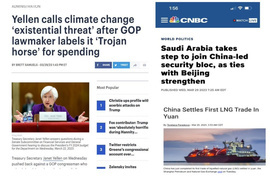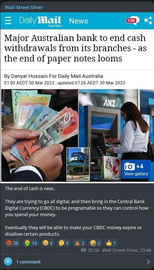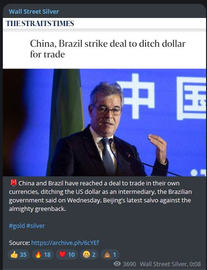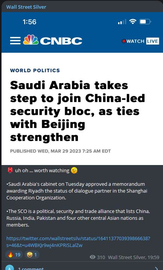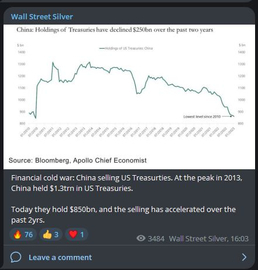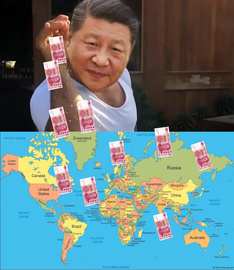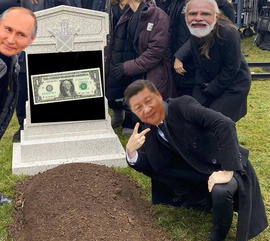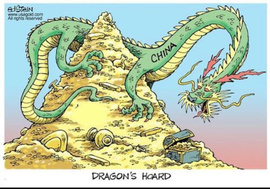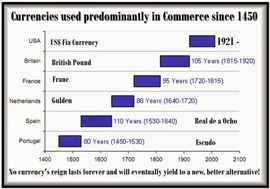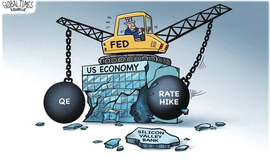Banking stuff edition. The dollar end is nye. Petrodollar first, than as world reserve currency and than domestically.
.................
The story of the U.S. dollar as the world’s reserve currency begins in the early 20th century, at a time when the global economy was shifting and power dynamics were changing. Prior to the U.S. dollar’s rise to prominence, the British pound sterling held the title of the world’s primary reserve currency due to the British Empire’s extensive trade and financial networks.
However, the economic landscape started to change with the growth of the American economy and the decline of the British Empire. The two World Wars played a significant role in this shift, as they weakened European economies and paved the way for the United States to emerge as a global superpower.
In 1944, representatives from 44 countries gathered in Bretton Woods, New Hampshire, to establish a new global monetary system in the aftermath of World War II. The Bretton Woods Agreement created the International Monetary Fund (IMF) and the World Bank, with the primary goal of promoting global economic stability and cooperation. One of the key decisions made at this conference was to peg global currencies to the U.S. dollar, which in turn was pegged to gold. This established the U.S. dollar as the world’s reserve currency.
The decision to use the U.S. dollar as the reserve currency was driven by several factors. The United States had emerged from World War II with a strong and growing economy, making it a stable and reliable choice. Additionally, the U.S. held the largest gold reserves in the world, which instilled confidence in the dollar’s value.
For a while, the Bretton Woods system functioned well, as it provided much-needed stability to the global economy. However, by the late 1960s and early 1970s, the system began to face challenges. The U.S. was struggling with inflation and balance of payments deficits, and the fixed exchange rates became increasingly difficult to maintain. This led to a growing concern that the U.S. would be unable to fulfill its commitment to redeem dollars for gold.
In 1971, President Richard Nixon announced the suspension of the dollar’s convertibility to gold, effectively ending the Bretton Woods system. This move, known as the “Nixon Shock,” marked the beginning of the era of floating exchange rates. Despite the end of the gold standard, the U.S. dollar remained the world’s primary reserve currency, as it was still seen as a stable and reliable option.
Since then, the U.S. dollar has continued to dominate global trade and finance, with central banks around the world holding large amounts of dollars in their foreign exchange reserves. The petrodollar system, which emerged in the 1970s after an agreement between the U.S. and Saudi Arabia to price oil exclusively in U.S. dollars, further cemented the dollar’s status as the world’s reserve currency.
The U.S. dollar’s role as the world’s reserve currency has its advantages and disadvantages. On one hand, it allows the United States to borrow at lower interest rates and gives the country significant influence in global markets. On the other hand, it also puts pressure on the United States to maintain economic stability and can lead to trade imbalances.
In recent years, there have been discussions about the potential for a shift away from the U.S. dollar as the world’s reserve currency, with alternatives such as the euro, the Chinese yuan, or even digital currencies being considered. However, for the time being, the U.S. dollar remains the dominant global reserve currency, playing a crucial role in international trade and finance.
........................
The story of the petrodollar begins in the early 20th century when the world started to rely more and more on oil as a primary energy source. As countries like the United States became major oil producers, oil started to be traded internationally, and it became crucial to have a stable currency for oil transactions. This led to the rise of the U.S. dollar as the dominant currency for global oil trade.
The term “petrodollar” refers to the U.S. dollars earned by oil-exporting countries, mainly in the Middle East, through the sale of oil. The birth of the petrodollar system can be traced back to the 1970s when the United States faced an economic crisis. The U.S. had abandoned the gold standard in 1971, which caused the value of the dollar to decline. In response, the Organization of the Petroleum Exporting Countries (OPEC) decided to raise oil prices to offset the loss of value in the dollars they received for their oil exports.
In 1974, the U.S. and Saudi Arabia struck a deal that would shape the global financial system for decades to come. In exchange for the U.S. offering military protection to Saudi Arabia and providing them with weapons, the Saudis agreed to price their oil sales exclusively in U.S. dollars. This agreement effectively made the U.S. dollar the global currency for oil trade and solidified the petrodollar system.
Other OPEC countries soon followed suit, and by the end of the 1970s, the majority of oil transactions worldwide were conducted in U.S. dollars. This created a huge demand for the dollar, which in turn helped to strengthen the U.S. economy. The petrodollar system also enabled oil-exporting countries to recycle their oil revenues by investing in the U.S. and other western countries, funding infrastructure projects, and purchasing arms and other goods.
Over time, the petrodollar system has become deeply embedded in the global economy, with the U.S. dollar serving as the world’s reserve currency. However, it has also faced challenges and criticism. Some argue that the system contributes to global economic imbalances and that the U.S. uses its economic power to exert political influence over oil-exporting countries.
In recent years, there have been discussions about alternative systems for global oil trade, such as using a basket of currencies or transitioning to a digital currency. Countries like China and Russia have also started to trade oil using their own national currencies in some cases, which could potentially challenge the dominance of the petrodollar.
In conclusion, the story of the petrodollar is a tale of economic, political, and strategic alliances that have shaped the global financial system for nearly 50 years. While the future of the petrodollar system remains uncertain, it is undeniable that the U.S. dollar’s role in global oil trade has had a significant impact on the world economy and geopolitics.
Be part of the movement!
Welcome to the community for those who value free speech, evidence and civil discourse.Create your free account
Recent Visitors 5
Photos 11,798 More
Posted by JohnHoukAI Dystopia Moving from Sci-Fi to a WEF NWO: A Look at Stop World Control Documentary, ‘THE END OF HUMANITY - As Planned By The Global Leaders’ SUMMARY: An intro by Patricia Harrity followed ...
Posted by JohnHoukGlobalist Tyranny Videos Batch – Part TWO SUMMARY: The video list I’m sharing leans more toward Globalist Tyranny (which includes the American traitors – the Dem-Marxists) in this batch.
Posted by JohnHoukGlobalist Tyranny Videos Batch – Part ONE SUMMARY: I’ve spent the last few days looking at saved videos largely from Telegram Social Media.
Posted by JohnHoukWATCH OUT FOR AN AI TYRANNY & NSA Spying SUMMARY: I’ve witnessed too many dark-side leaps and bounds to give credence to AI-Tyranny naysayers.
Posted by Sensrhim4hizvewzCohencidence or PLANNED???
Posted by Sensrhim4hizvewz Hopefully, everyone catches it and everyone gets better
Posted by JohnHoukFBI Investigates Baltimore Bridge Collapse! Suggests NOT an Accident! SUMMARY: On 3/27/24 I shared a Lara Logan Tweet on her opinion of what caused the Francis Scott Key Bridge near Baltimore ship ...
Posted by JohnHoukPolitical Tyranny – Part Two Videos Showing the Political Tyranny of Factionalism & Globalist Entanglements SUMMARY: IN Part 1 I used President Washington’s 1796 Farewell Address as a ...
Posted by JohnHoukPolitical Tyranny – Part One President Washington Warned of the Insidious Outcome of Political Factions & Foreign Entanglements SUMMARY: George Washington – RIGHTLY SO – is called the Father...
Posted by JohnHoukFuellmich Political Persecution Encapsulates Globalist Lawfare SUMMARY: A few thoughts on Deep State Political Persecution of Trump & Supports.
Posted by JohnHoukLooking at Birx Not Fauci Managed Medical Tyranny Includes Personal Observations on Legit President Trump SUMMARY: Looking at a VNN examination of the short Documentary: “It Wasn't Fauci: How ...
Posted by FocusOn1Uh oh, i hate to say this, but israel was formed in 1948, 100 years after karl marx wrote his book. Was it formed as a atheist communist country?
Posted by MosheBenIssacWith woke fat ass acceptance, only applies to women (fat bitches). What used to be funny is now illegal. The video won a Grammy Award for Best Concept Music Video in 1988 [youtu.be]
Posted by JohnHoukRemember WHY You Are Resisting the Coup Summary: Well… It’s series of videos time again.
Posted by JohnHoukA Call for Intercession Over WHO Power Grab Treaty SUMMARY: A call for prayer on America’s leaders related to the National Sovereignty terminating Pandemic (better known as Plandemic) Treaty.
Posted by MosheBenIssacDisney COLLAPSES Billions Lost In MINUTES After Shareholders Troll Company Sticking With WOKE! [youtu.be]
